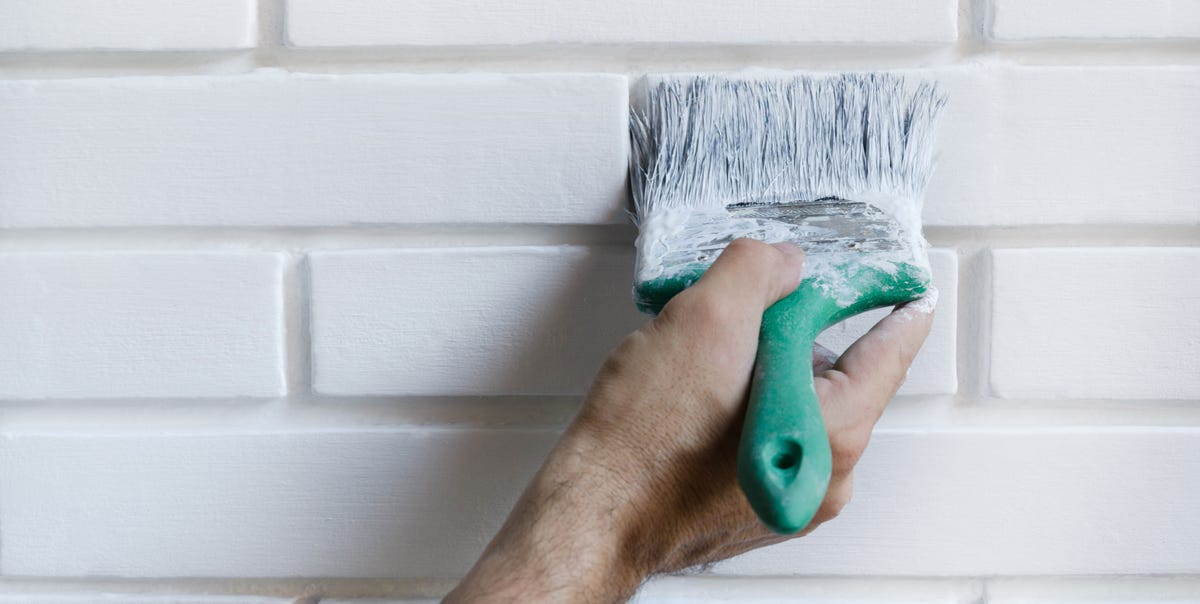There’s nothing like painted brick to give your home or office that classic, solid feel. It doesn’t go out of style, easily maintainable, and lets you put a personal spin on things with different colours.
Whether you want to a rustic, country look or something more sleek, painting your exterior brick wall is a fantastic, cost-effective solution!
However, like anything worthwhile, learning how to paint a brick wall takes a little elbow grease and some know-how.
In this guide, we’ll outline every stage of the process, from prepping the wall to choosing the right paint (and primer) for your needs.
By the end, you’ll be an expert on painting a brick wall like a pro!
- Related article: What to Expect When Pressure Washing Your House
Let’s kick things off with the materials and supplies you’ll need to get started:
Table of Contents
Materials and Supplies You’ll Need to Paint Your Brick Walls
- Drop cloths
- Painter’s tape
- Pressure cleaner or hose
- White vinegar
- Paint brush or roller
- Extension pole or ladder for high walls
- Paint tray
- Acrylic caulk
- Wire Brush
Step by Step on How to Paint Brick the Right Way
We know it’s tempting to get the old paintbrush out and start painting away, but some preparation is needed first.
Let’s go through the process step by step so you know exactly what needs to be done:
Clean and repair your exterior brick wall before painting
- Evaluate your brick wall for any cracks, crumbling mortar, leaks, damp rising or other defects. While holes can be filled with acrylic caulk or grouting cement, large cracks or crumbling areas will need to be repaired before painting.
- If you see efflorescence, which is a build up of white crystal salts, it must be removed before you can continue. Do so by mixing a 5% solution of white vinegar and water and apply the mixture to the wall with a cloth. Proceed to leave it on for 15 minutes and then rinse it off.
- Alternatively, you can use soapy water and a wire brush to remove any efflorescence. Ensure your brick surface is clean by sweeping it with a broom and then washing it down with a hose or pressure cleaner. A dirty wall will prevent paint from adhering correctly.
- Lastly, use masking tape to protect any surfaces you don’t want painted, such as windowsills, door frames or gutters. To protect your floors, lay down a drop cloth or old sheets.
Prepare your paint for your exterior brick
- Open your paint can and stir the contents thoroughly. If you’re using a paint sprayer, thin the paint according to the manufacturer’s instructions.
- Wash your paint brush and roller before putting them in the paint – the dampness helps your roller and brush soak in more paint.
Cut in around the edges
- Pour a small amount of paint into your tray then dip just your brush’s tip into the paint. You’ll ideally want an angled brush so you can get into all the nooks and crannies.
- Begin to paint around your wall’s perimeter and any edges using a brush. This process is called “cutting in” and doing it before using a roller will create cleaner lines.
- Start at the top and make your way down the wall.
- Our last tip is not to cut in too far ahead – your paint should still be wet when you start using the roller.
You should also read: 9 Signs It’s Time For Exterior Painting
Apply primer
Primer is a necessity for painting brick wall, whether it’d be interior or exterior brickwork. It helps the paint to stick to the surface and provides a consistent background for your topcoat.
- Soak your brush or roller in latex primer and begin to apply it evenly across the brick wall.
- Apply a second coat of primer on sections that were affected by mildew or efflorescence as these will need extra protection.
Use a roller to paint your exterior brick
- Load your 18 nap roller into your paint tray and ensure your latex paint is evenly distributed across the entire roller. Overloading will stop your roller from spinning smoothly and cause paint to drip.
- Begin rolling from the bottom up, or in an M pattern. Proceed to paint in smaller sections until your wall is entirely covered.
- Once fully painted, use a wet roller to gently roll over the entire wall. This will help to remove any roller marks and ensure a beautiful, even finish. This process is known as “laying off.”
- Repeat the process, overlapping any strokes you made before the paint had a chance to dry.
- Let your first paint coat dry, which should typically take 2 hours and apply your second coat using the same process. Let the paint dry for the recommended time on the paint can and remove all drop cloths and tape.
Things to do and avoid when painting brick
While a how-to guide on painting a brick wall can achieve a sublime, professional finish, there are always a few things you should avoid.
Rookie mistakes can leave you with paint flakes and cracks, streaks, or cause your wall to omit a chalky white substance that can be difficult to remove.
Here are some things you should take into account when painting brick:
Never paint on a recently built brick wall
We know it can be tempting to add a lick of paint to exterior brick once it’s installed, but give it time to cure first.
New bricks can omit a powdery substance which can prevent paint from adhering correctly. Wait at least four weeks before considering painting newly installed bricks.
Always ensure a clean brick surface
Loose dirt, debris, mould, and grime can all lead to a bad paint job. Make sure you thoroughly clean your surface before beginning to paint.
You can use soap and water to thoroughly clean the surface and let it dry completely before painting.
Choose the right paint
While we’ve covered exterior brick painting, interior brick will require a different paint. A water-based acrylic latex is typically the best choice for exterior brick.
Similarly a 100% based acrylic latex paint formulated for masonry is ideal for interior brick.
If you’re painting the interior wall of your brick fireplace, opt for heat-proof paint to avoid any damage.
This paint type protects the surface against rapidly changing temperatures that your fireplace will undoubtedly reach.
Be mindful of the weather
You should always check the forecast before painting brick.
The best temperature for painting is at least 50° F, as any lower and the paint will take longer to dry. This can cause your paint to flake or crack, resulting in a subpar finish.
Patch any cracks and holes
Before you start painting, it’s important to fill in any cracks or holes in your brick wall. This will create an even surface to paint on and prevent any paint from seeping through the cracks.
Use an Epoxy mortar to repair any cracks, and any other wall defects. And once dry, sand the brick until it’s smooth and free of dust before painting.
Reasons so many homeowners paint their brick walls
Brick is a classic and timeless building material, but that doesn’t mean it can’t be improved with a fresh coat of paint.
Homeowners might paint their brick for a number of reasons:
To change the colour of the brick
It’s not unusual for your exterior brick to look completely out of place once it’s installed.
If you’re not happy with the natural colour of your brick, a paint job will transform its appearance.
You can either make your brick wall to be a standout feature or make it blend in with the rest of your home.
To protect the brick from the elements
We all know Northern Virginia experiences some extreme weather conditions, from blistering hot summers to freezing cold winters.
And while brick is a durable material, it’s not immune to the effects of the elements.
Paint acts as a barrier between your brick and the elements. By painting your brick, you can protect it from water damage, sun damage, and other wear and tear.
It can add a classy touch
A red brick wall might be too industrial for some, but to others it adds a more classical and timeless look to their home.
White and beige accents, on the other hand, can make your home look more modern.
Painting your brick exterior adds curb appeal
We’ve all at least stopped once to admire a beautifully painted home while driving through our neighbourhoods.
A fresh coat of paint really elevants your home, can make the difference between a home that looks well-cared for and one that doesn’t.
Not only does a new paint job add value to your home, but it also makes it more likely to sell if you ever do put it on the market.
It’s a relatively easy and inexpensive project
If you’ve read this far, you already know painting a brick wall isn’t as daunting a task as it might seem.
And while it’s not exactly cheap, it’s also not an overly expensive project. When compared to knocking down and rebuilding a wall, painting is much more affordable.
It’s also not a particularly time-consuming project. Once you’ve prepared your wall, it’s a simple case of applying your coats of primer and paint.
You can easily do it in a weekend, or even just a day if you’re only painting a small section.
Need Your Exterior Brick Painted? Trust the professionals at Benjamin Painters
If you’re considering painting your exterior brick, get in touch with the Virginia house painters at Benjamin Painters.
We specialize in all things painting, including exterior brick walls, cabinets, fences, and house interiors and will work with you to achieve the result you desire.
While the process of painting a brick wall may seem straightforward, achieving professional results requires the right techniques, tools, and knowledge.
If you’re located in Nortern Virginia and need assistance with your painting project, consider hiring the services of Benjamin Painters, a professional Virginia painting company with a proven track record of delivering high-quality work.
With their expertise, you can transform your brick wall and elevate the overall aesthetics of your property.
You can discuss the perfect shade for your exterior during our colour consultation and experienced painters will make sure the job is done right, from start to finish.
We service Fairfax, VA, Arlington, VA, Loudoun County, VA, McLean, VA, Great Falls, VA, Potomac, MD, Bethesda, MD, Chevy Chase, MD, Rockville, MD, Gaithersburg, MD, Georgetown, DC, Adams Morgan, DC, Northwest Washington DC.



0 Comments